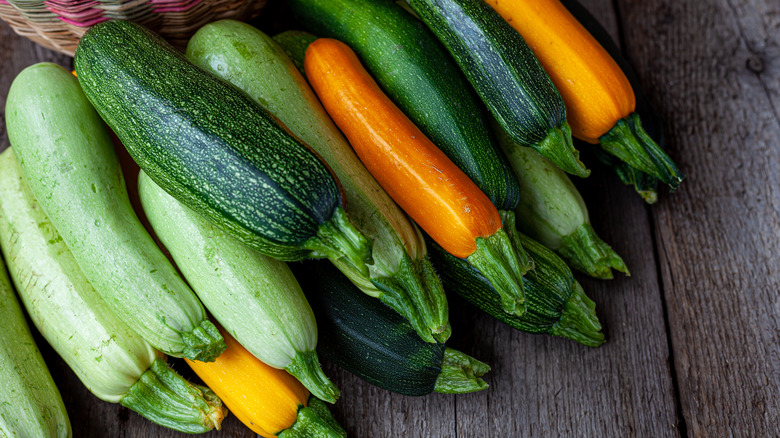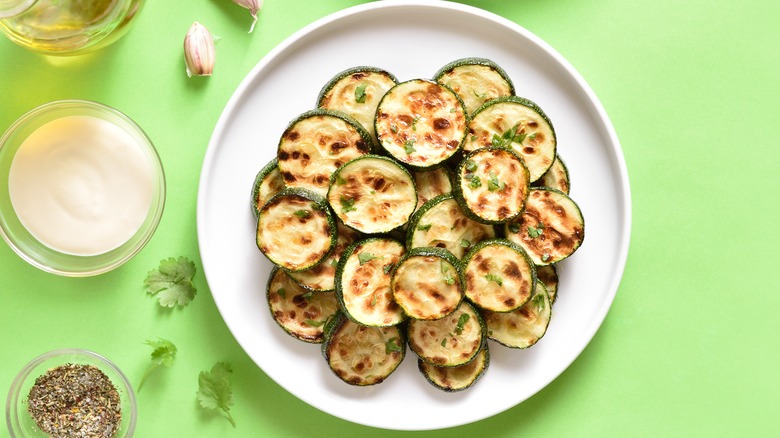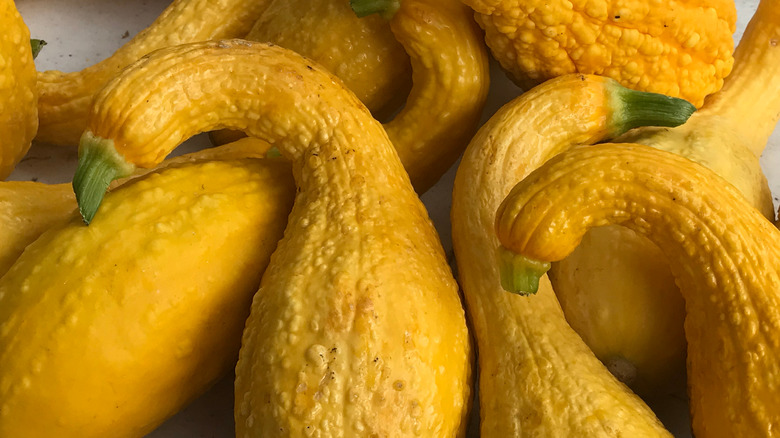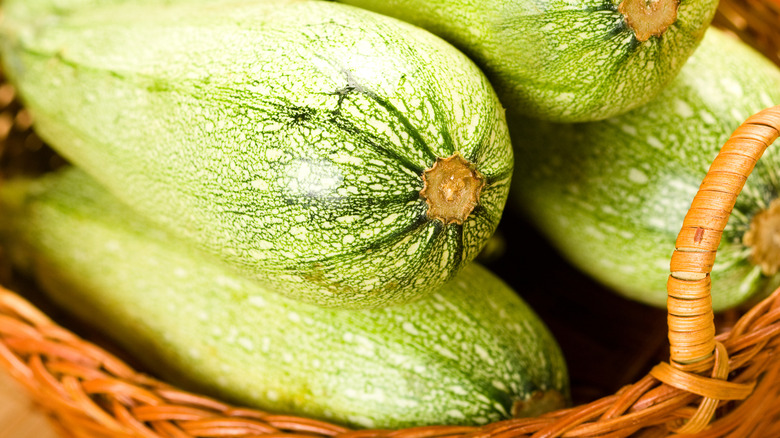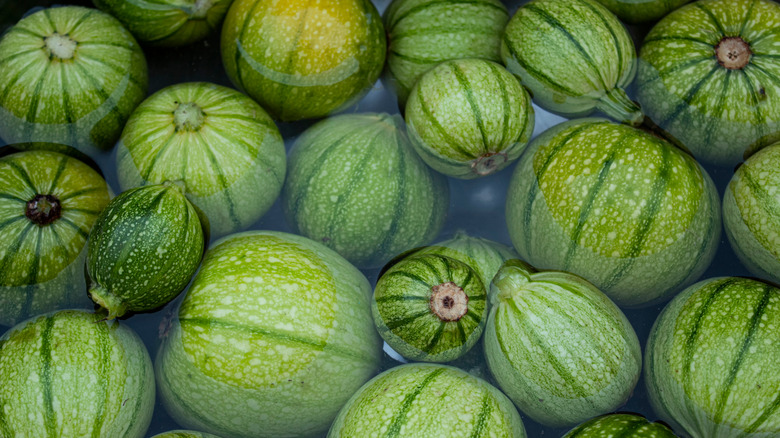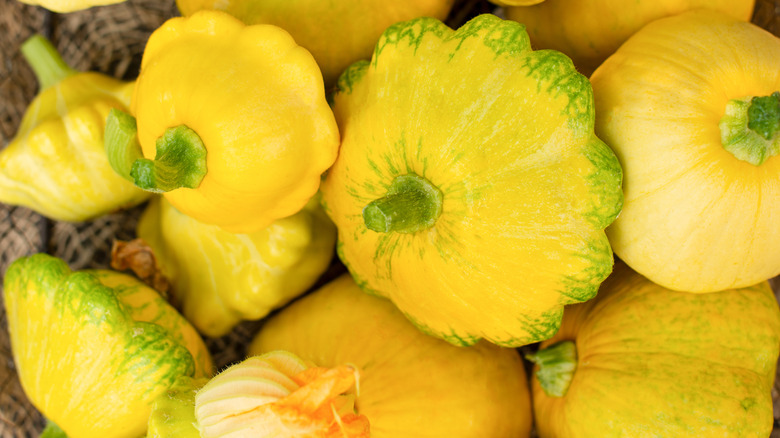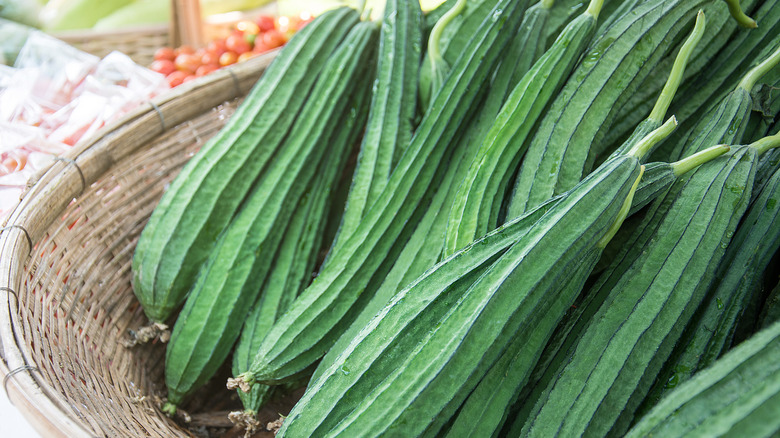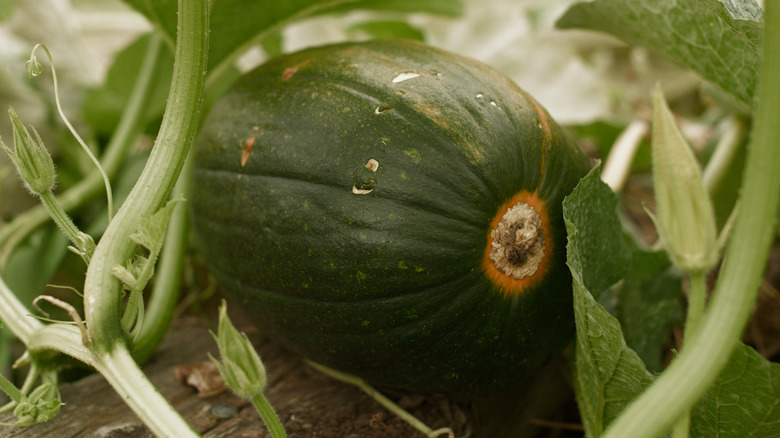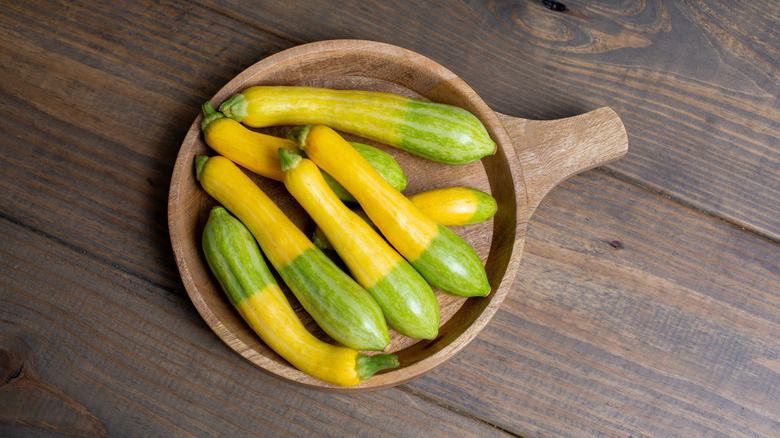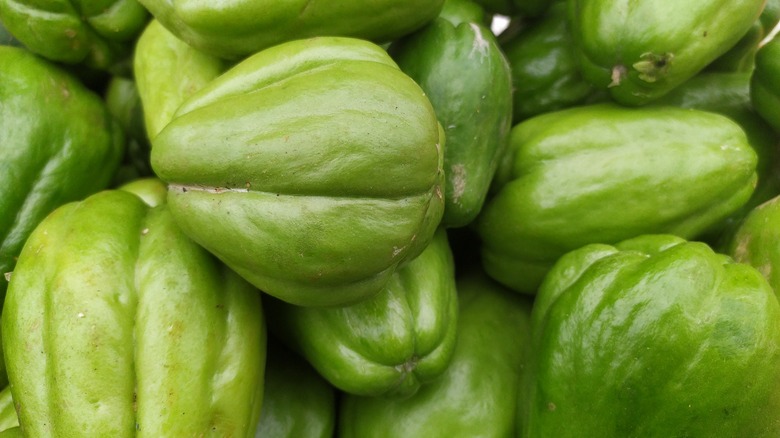9 Types Of Summer Squash And How To Cook Them
Squash is a familiar presence in our foods. The veggies delight our plates throughout the year in varying colors, textures, and flavors. They're at home in ratatouille and hearty soups alike, and they're just as yummy when glazed in olive oil and roasted. Squash has long been in the spotlight, but no matter how familiar it is, there's always something new to learn.
For squash neophytes, the plant family can be broken down into two types: summer squash and winter squash. True to its name, summer squash matures late in the summer or early in the fall, and it gets picked after less time on the vine. It also has thinner, more tender skin. The University of Nebraska notes that, when picking out summer squash, make sure it's glossy, bruise-free, and firm to the touch. The publication also notes that the squash should feel heavy for its size. There are many different kinds of summer squash, and that means there are particular things to keep in mind when you pick them out. Below are nine kinds of summer squash, what makes them unique, and how to cook them.
1. Zucchini
Zucchini, also known as courgette, has long been a favorite in private gardens and grocery stores alike. Technically a fruit, Encyclopedia Britannica describes most zucchini as typically dark green in color and cylindrical in shape, but some zucchini varieties can range from yellow to dark in color. Zucchini's flavor is best described as mildly sweet, though there's a certain earthiness to the skin, especially in comparison to yellow summer squash. Overripe zucchinis tend to be bitter. Home Guides notes that telltale signs of zucchini decay are dull skin, rotting spots, and a generally mushy texture.
Ripe zucchinis sautéed in butter or oil are mouthwatering. Grilling and roasting are also tried-and-true methods of brightening this milder produce up. For cooks who are looking to indulge a bit more, go for some classic recipes. Fried zucchini has long been a staple in Italian restaurants but can be recreated just as easily at home. Try dunking zucchini slices in beaten egg and coating them in a bread crumb-parmesan mix before frying. While marinara may be the go-to route for this antipasti, the recipe suggests ranch or a sour cream-mayo mix make for a more pub-like atmosphere.
2. Crookneck
Wild squash has its origins in the Americas and is believed to have first grown in Central America and Mexico (via SeedChange). Among the oldest documented squash varieties is the appropriately named crookneck squash, which was first recorded in colonial times, according to Specialty Produce. In fact, the site notes that the squash's earliest surviving written appearance was in Thomas Jefferson's garden book. Besides its bright yellow hue, the aptly named crookneck's most distinctive feature is its crooked neck. LiveStrong says not to be daunted by this squash's shape and advises cutting the crookneck as you would any other squash. However, it does acknowledge the slight challenge of cutting a crookneck and suggests exercising some finesse when cutting around the plant's curved neck.
Crookneck's flavor profile is mild yet sweet, and its sturdiness allows for excellent raw and cooked dishes, per Specialty Produce. With a lean diet in mind, LiveStrong proposes using grated crookneck squash to add bulk, moisture, and color to dishes. So, don't be surprised if you see this squash in pancakes, breads, and raw salads. Specialty Produce advises incorporating the crookneck into classic Mediterranean dishes like carpaccio and ratatouille. The outlet also offers up one other traditional route: This summer squash's particular flavor profile pairs well with toasted nuts and cheese. It would definitely help make a charcuterie board bright.
3. Cousa
Cousa, or cousa magda, is a Middle Eastern eggplant variety referred to as the best-tasting Middle Eastern style eggplant, according to Specialty Produce. The name "cousa" actually means squash in Arabic. Specialty Produce describes cousa's flavor profile as "sweet yet nutty" and likens it to Zephyr squash. It's clear why cousa is a staple of Middle Eastern cuisine. The best time to buy cousa is from June onwards. It is at this point that cousa has flourished flavorfully, which makes this variety a summer squash through and through.
Cousa magda is, like most summer squashes, mild. This makes it perfectly suited for many different types of cooking: sautéing, grilling, and roasting are all bound to have great results. Cook's Info does note that cousa magda can be cooked similarly to the zucchini, though it's noticeably more plump. Cousa's plumpness, according to the outlet, makes it the perfect size for stuffing as well. But, there is one part of cousa that makes it a bit finicky. As Specialty Produce observes, the thin skin of the squash is easy to overcook: A little bit of heat is just enough to cook this squash perfectly.
4. Eight ball squash
Eight ball squash is, simply put, unmistakable. It's not hard to see where the squash's name comes from when you glance at the fruit's extremely round shape. In fact, the shape makes it incredibly easy to distinguish good eight ball squash from bad. As the squash gets larger, it will begin to take on a bitter and "woody" taste (via Produce Market Guide). The guide describes the squash's size as "an inch in diameter to the size of a softball." When at its best, this summer squash's flavor is rich and nutty and close to Italian zucchini in flavor.
Eight ball squash has a beautiful dark green color that is intercepted with darker green stripes and white mottling. Per the Produce Market Guide, the eight ball squash can be served and enjoyed raw. Hobby Farms, however, recommends using the eight ball squash as a stand-in for cousa and suggests stuffing the squash with a mix of rice, meats, and vegetables and topping it with cooked tomatoes. The site notes that eight ball is really at its best size for stuffing when it's around the size of a baseball. Typical of summer squash, the skin of the eight ball squash is incredibly tender, and one should take care not to nick it.
5. Patty pan squash
The UFO-shaped patty pan squash is a sight to behold: out-of-this-world shapes that look as intergalactic as they do floral. The squash is just as yummy whether it's green, yellow, or white, which lends a particular visual edge to any plate they grace. Hobby Farms says patty pan squash can be used interchangeably with zucchini and yellow zucchini. This squash does well when grilled, sautéed, or roasted. Though, as the site notes, there are other uses for this petite summer squash. For one, their unique shape makes them exceptionally well suited for topping burgers.
MyRecipes warns that, even if patty pan tastes like zucchini, it can't be treated the same way. It points to its shape as the most obvious hurdle. Smaller patty pans are, according to the page, a bit more manageable, but their rougher edges should still be cut to help even them out. The outlet sees larger patty pans as the less forgiving of the bunch: It advises slicing or cooking them whole. Stuffing is another recommended, and perhaps easier, use. MyRecipes recommends cutting a flat base and using a melon baller to scoop out seeds. For a fascinating twist, the site suggests baking an egg into the pattypan for an extremely rich filling.
6. Luffa (sponge gourd)
Luffa is also called loofah, like the sponge. No, this isn't a coincidence. The luffa squash's dried fibers have long been used to exfoliate skin and clean up the house (via Specialty Produce). There's certainly a lot going on with this squash, but its culinary uses shouldn't be overlooked. The gourd can grow up to 60 centimeters in length, but like most summer squashes, as the fruit matures, it loses the sweet flavor that makes it so yummy. Specialty Produce says luffa is harvested around 12 centimeters in length. At this length, the squash has a rich green color and deep ridges. Its flesh is creamy white, and while it's zucchini-like in flavor, the luffa is uniquely silky smooth in texture.
Luffa has long been enjoyed around the world. While some prefer to enjoy luffa served raw like a cucumber, it's not uncommon to see this gourd being added into chutneys or stir-fries. The outlet says steamed luffa stuffed with pork is a great way to make use of its flavors and firmness. Good Housekeeping says not to forget about the luffa's flowers and tiny fruits, which the magazine describes as having a similar flavor to summer squash. There's not much that needs to be done in terms of preparing them. They are best enjoyed washed off and raw.
7. Tatume
Tatume, also known as Mexican squash, is another squash that traces its long lineage back to Mesoamerica and has remained a major part of Mexican cuisine throughout history (via Specialty Produce). It can both be enjoyed in both winter and summer varieties and comes in a variety of shapes. Tatume can be harvested oblong or round, and summer tatume are, according to Loam Agronomics, light green with stripes and almost resemble an immature watermelon.
Tatume summer squash are harvested earlier, while their skin and flesh are still tender to the touch. Despite this softness, the flesh of the tatume squash is still much firmer in comparison to other summer squash varieties, per Loam Agronomics. Notably, tatume is bold in flavor. This leads to a real knockout in cooking, and tatume can be found occupying space on the grill, on the stove, or in the oven. The outlet says oblong tatume make for excellent squash patties and can be sliced and grilled up with gusto. You won't want to miss out on the tatume plant's flowers either — they're extremely flavorful.
8. Zephyr
Zephyr squash is unique because it's a hybrid. This is probably an easy conclusion to draw, given the squash's unique two-tone appearance that almost looks like it's been dip-dyed. This boldly colored squash was created by crossing yellow crookneck with delicata and yellow acorn squash varieties (via Harvest to Table). This hybrid variety is characterized as sweet yet nutty and firm, which solidifies that this particular squash is great for quick cooking.
Specialty Produce notes that the squash can be enjoyed in a variety of sizes and will still hold its own flavor-wise. Its particular flavor profile, according to the site, works nicely with other summer vegetables, seafood, and fresh cheeses, among a plethora of other goods. Similarly, in itself, the zephyr squash is just as versatile. The hybrid variety can be enjoyed raw, grated, grilled, and what have you, all while retaining its amazing flavor. There is one thing to keep in mind when cooking with zephyr; Harvest to Table advises draining the squash. This helps remove excess water and improve flavor. To drain squash, slice it, arrange it in the bottom of the pan, and sprinkle it uniformly with coarse salt. Let it dry for 20 to 30 minutes, et voilà, the squash is ready to party. As Harvest to Table notes, make sure to trim the ends of zephyr and cut it into chunks before cooking.
9. Chayote
Chayote can be found in many forms across South America and the Caribbean (via the Los Angeles Times). This bright green squash looks like a shriveled pear, but has a bright white center. Chayote's flesh tends to vary, as described by Specialty Produce, from crisp to starch. But it becomes richer as it ages. Its flavor profile has been described as having a hint of sweetness. Like other summer squashes, chayote flowers can also find a place at the dinner table. Good to note is that chayote tendrils are ripe for picking and eating.
The chayote squash pairs well with many dishes. Specialty Produce lists an incredible list of pairs for this squash: curries, mole, both hard and soft cheeses, lemon and lime juice, and curry. Safe to say, this particular variety has a lot to offer. Really, this is just scratching the surface of all this squash can do. As the L.A. Times observes, in the French Caribbean, chayote is baked with cheese and chilies. In Puerto Rico, the squash is served with scrambled eggs and ham. In Miami, it can be found served up with fish. The possibilities are endless. Universal advice when it comes to enjoying this squash is peeling off the skin before cooking, as it tends to be harsh and bitter in comparison to the rest of the fruit.
